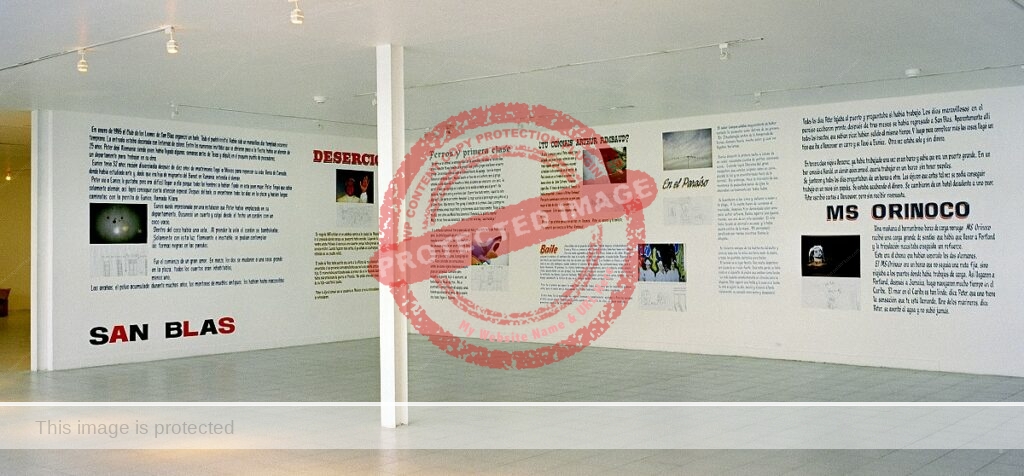Multi-talented German artist Paul “Pablo” Huf, the elder son of two professional artists closely associated with Ajijic – Peter Paul Huf and Eunice (Hunt) Huf – was born in Guadalajara in October 1967. According to his parents, his first word was alacrán (scorpion) because of the large number of those arachnids that shared their humble adobe-walled village home.
When Paul was six years old, the family moved to Europe, where they lived for a couple of years in southern Spain before eventually settling in Peter Huf’s home town of Kaufbeuren in Bavaria, Germany.
Paul Huf became an artist late in life and eventually returned to Mexico, at age 40, after finding a box of his parents’ photos and mementos of Mexico. He carried scans of them with him as he researched the story of how his parents first met and fell in love. This story formed the basis for Pablo Huf’s fascinating contribution to a group exhibition by German artists in Mexico City in 2007.
Huf does not consider that having being born in Mexico has had any particular influence on his art. His inclusion in this series of profiles of artists associated with Lake Chapala is justified on two counts: first, the fact that he spent his early childhood in Ajijic and, second, that he subsequently researched the history of his parents’ links to Ajijic and other parts of Mexico.
In his twenties, Paul Huf worked for several years as a car mechanic, studied social work and became a parole officer in Munich, but at the age of 30, he suddenly switched tracks and began seven years of formal art studies at the Academy of Fine Arts in Munich and at the Fine Arts Academy in Valencia, Spain. Since completing his studies in 2004, he has steadily built a career as a professional artist, with extended working periods in Sibiu (Romania), Amsterdam and in Pas du Calais (France).
Paul Huf’s artistic works combine photography, drawing and concept arts with writing.
Prior to his Mexico City exhibit, Huf spent time researching other artists who had been close friends of his parents in Mexico (such as Jack Rutherford, John K. Peterson and the other members of Grupo 68) and then spent three months in Mexico visiting places where his parents had been more than forty years earlier, including San Blas, Ajijic, Zihuatanejo, Oaxaca and Veracruz. One of his most surprising encounters was with someone who remembered partying with his parents in Zihuatanejo back in the mid-1960s!
Based on his travels, Huf wrote ten short texts that became the thread linking the photographs and drawings in his contribution (“40 Años”/”Forty Years”), which was 3 meters in height and occupied 24 meters of wall space in the group exhibition entitled Vistazo, La transformación de lo cotidiano, (“Glance, The transformation of everyday life”). (The other artists in this show, held at the Museo Carrillo Gil in Mexico City from 15 March to 10 July 2007, were Uli Aigner, Benjamín Bergmann, Heike Dossier, Martin Fengel, Tom Früchtl, Haubitz+Zoche, Heribert Heindl, Endy Hupperich and Martin Wöhrl). Huf’s short stories were painted “Mexican style” on the walls of the museum by two rotalistas (Mexican advert painters/calligraphers). In conjunction with the display, slides of old family photos, newspaper clippings and examples of the invitation cards used for 1960s art exhibitions were projected onto the wall.
As Paul Huf rightly concluded, and his exhibit demonstrated, his parents’ Mexican love story is both special and glamorous. In 2014, when my wife and I had the opportunity to visit his parents, it was evident that both Eunice and Peter Huf had particularly fond memories of Ajijic in the 1960s and felt honored to have had their story publicly retold by their son. It was equally clear that their time in Mexico had continued to exert a very strong influence, especially on Peter’s own artwork.
Paul Huf currently lives in Munich, Germany, with his wife and two young children. He returned again to Mexico in 2008 and showed work in an exhibition entitled Hermandades Escultoricas (“Sculptural Brotherhoods”) at the Museo Fernando García Ponce-Macay in Mérida, Yucatán.
Huf has regularly exhibited works in Munich galleries since 2000. In addition, he has participated in shows in Rimini, Italy (2002); Amsterdam (2006); Belgium (2008); Sibiu, Romania (2008); Dunkirk, France (2008); Pecs, Hungary (2010) and Berlin, Germany (2011).
His work, ranging from a radio play to a “soccer-literature contest”, has won several awards, and one of his diptychs (two hinged plates), a work entitled “USA, 2005” was acquired for the Bavarian State Painting Collection. As a writer, he has published several collections of short stories, including You have to be as cool as Alain Delon, sagte Zelko (2006) and Vom Tod und vom Alkohol (“Of death and alcohol”) (2006).
Paul “Pablo” Huf may have tried in his twenties to escape the artistic magnetism of a childhood at Lake Chapala, but his inner creative drive eventually emerged and won out. The journey he then undertook to retrace his parents’ love story and compile an exhibit to celebrate his family’s time in Mexico, makes his contribution to the art world, and to the story of the artists associated with Lake Chapala, a very special one.
Acknowledgment
I am very grateful to Paul Huf for generously sharing memories and information about his life and career via emails and Skype (September 2016; February 2017).
Sombrero Books welcomes comments, corrections or additional material related to any of the writers and artists featured in our series of mini-bios. Please email us or use the comments feature at the bottom of individual posts.
Tony Burton’s books include “Lake Chapala: A Postcard History” (2022), “Foreign Footprints in Ajijic” (2022), “If Walls Could Talk: Chapala’s historic buildings and their former occupants” (2020), (available in translation as “Si Las Paredes Hablaran”), “Mexican Kaleidoscope” (2016), and “Lake Chapala Through the Ages” (2008).
